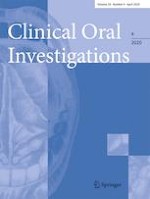Erschienen in:

06.11.2019 | Original Article
Orthodontic cell stress modifies proinflammatory cytokine expression in human PDL cells and induces immunomodulatory effects via TLR-4 signaling in vitro
verfasst von:
Jana Marciniak, Stefan Lossdörfer, Isabel Knaup, Asisa Bastian, Rogerio B. Craveiro, Andreas Jäger, Michael Wolf
Erschienen in:
Clinical Oral Investigations
|
Ausgabe 4/2020
Einloggen, um Zugang zu erhalten
Abstract
Objective
Biomechanical orthodontics loading of the periodontium initiates a cascade of inflammatory signaling events that induce periodontal remodeling and finally facilitate orthodontic tooth movement. Pattern recognition receptors such as toll-like receptors (TLRs) have been well characterized for their ability to induce the activation of inflammatory, immunomodulatory cytokines. Here, we examined whether the cellular response of human periodontal ligament (hPDL) cells to mechanical stress involves TLR-4 signaling in vitro.
Materials and methods
Confluent hPDL cells were cultured in the presence of 5 μg/ml TLR-4 antibody (TLR-4ab) for 1 h prior to the induction of compressive forces by the use of round glass plates for 24 h. At harvest, interleukin-6 and interleukin-8 (IL-6, IL-8) mRNA and protein expression were analyzed by real-time PCR and ELISA. The immunomodulatory role of mechanical cell stress and TLR-4 signaling was addressed in co-culture experiments of hPDL and THP-1 cells targeting monocyte adhesion and by culturing osteoclastic precursors (RAW 264.7) in the presence of the conditioned medium of hPDL cells that had been mechanically loaded before.
Results
Basal expression of IL-6 and IL-8 was not affected by TLR-4ab, but increased significantly upon mechanical loading of hPDL cells. When cells were mechanically stressed in the presence of TLR-4ab, the effect seen for loading alone was markedly reduced. Likewise, monocyte adhesion and osteoclastic differentiation were enhanced significantly by mechanical stress of hPDL cells and this effect was partially inhibited by TLR-4ab.
Conclusions
The results of the present study indicate a proinflammatory and immunomodulatory influence of mechanical loading on hPDL cells. Intracellular signaling involves a TLR-4-dependent pathway.
Clinical relevance
These findings hold out the prospect of interfering with the cellular response to mechanical cell stress in order to minimize undesired side effects of orthodontic tooth movement.











